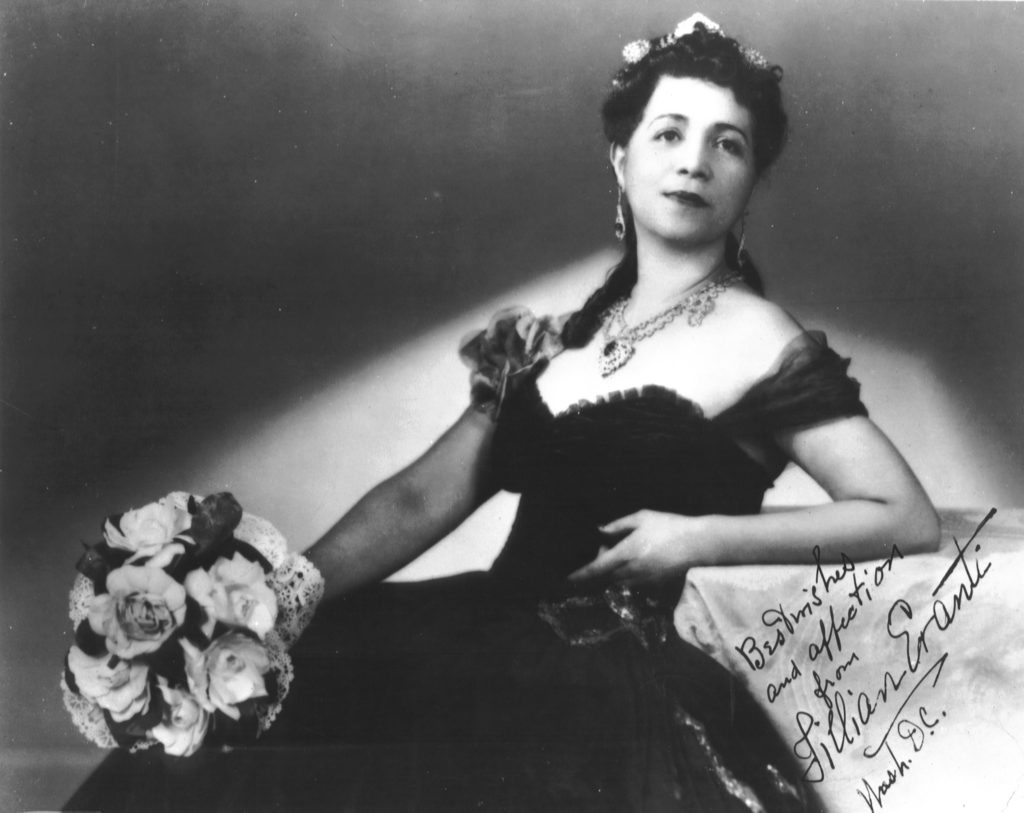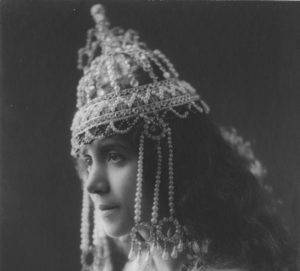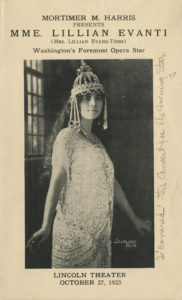As we continue to mark Women’s History Month, we are looking back at the remarkable story of Opera Diva Lillian Evanti, an African American trailblazer whose professional life was limited by the era of segregation in the United States. DC History Center volunteer Blair Forlaw adapted her story from “Lillian Evanti: Washington’s African-American Diva” by Eric Ledell Smith, published in the spring/summer 1999 issue of Washington History Magazine.[i]
An Operatic Trailblazer
One critic said: “She was tall, slender with warm dark eyes, pretty black hair and a pair of lips made for song.” Another remarked that she had “a strikingly colorful voice – vibrant, dynamic and compelling.” The diva herself said: “I was a few years too soon; I was ahead of my time.” [ii]

Looking back decades after her death in 1967, Madame Lillian Evanti’s story bears witness to the obstacles and the opportunities that shaped the lives of African American artists in Washington during the segregation era (roughly 1896-1954). She was an accomplished lyric soprano, a teacher, an international inspiration. She was a daughter, a mother, a friend. She endured the snubs and injustices of racial discrimination and the heartaches of a troubled marriage. But she never gave up. Washingtonians remember her today as a trailblazer whose contribution to the city’s cultural life is surpassed by few.
Born Annie Lillian Evans in 1890, the artist grew up in a highly cultured and civically connected household. Her parents descended from antebellum free Blacks in Maryland and Ohio, some of whom were legends in the family for their activism in the anti-slavery struggle. At the time of her birth, Lillian’s parents and grandparents were living on a farm in the then-rural Benning neighborhood in Northeast DC, due east of the Capitol.
Young Lillian was a precocious child and singer, encouraged by adoring parents. She first performed publicly in 1894 at age four in a charity benefit held at Friendship, the Wisconsin Avenue NW home of Washington Post owner Edward B. McLean. “Perched on a table,” she wrote in her memoir, “I had on a starched white pinafore and cotton stockings and my hair was tied with red ribbons. There was nothing backward about me. I simply burst forth into song.”[iii]
In 1904 the Evans family purchased a two-story Victorian rowhouse at 1910 Vermont Avenue NW, one block south of U Street and near the campus of Howard University. Now on the National Register of Historic Places, the gray brick house had a large front bay window, a tiny front yard, and rear yard with an outhouse. This house became very special to Lillian; indeed, when in Washington as an adult, she refused to live anywhere else. “This house became my anchor through all my life,” she wrote. “Each square foot has a vivid memory; each piece of furniture and picture a glorious past.”[iv]
Possibly the most precious piece of furniture in the house was the piano purchased for young Lillian by her father, who engaged a German music teacher to teach her to play. The adult Evanti remembered that when her father heard her playing favorite sonatas by Liszt, Chopin, or Beethoven, he would stand by the piano, “waving a pencil as a baton and looking like a great maestro.”[v] These early experiences helped cement her determination to pursue music. As a teenager, she sang in public at every opportunity—church socials, school commencement exercises, holiday celebrations—and fantasized that one day she would be a professional singer.
In the Heart of U Street
The house at 1910 Vermont Ave NW was situated amid one of the most lively and exciting places for African American intellectuals and artists to be in the early 20th century. Popularly known as “Black Broadway,” the U Street corridor was the heart of the New Negro Movement in Washington, which seeded what became known as the Harlem Renaissance in New York. Its theaters, restaurants, and shops attracted Black patrons from all over. It was not unusual to see celebrities such as Cab Calloway, Pearl Bailey, Duke Ellington, or Langston Hughes performing in or traveling through the neighborhood.
Institutions of learning fueled the creativity and accomplishment in this part of Washington—a culture that suited the Evans family well. Generations of Evanses placed a premium on education, availing themselves—both as students and teachers—of the academic resources available to African Americans in DC after the Civil War. In fact it was the opportunity for graduate studies at nearby Howard University that attracted Lillian’s father to the city.
Lillian thrived in this environment. She graduated from Armstrong Manual Training School in 1908, followed by studies at Miner Teachers College, where she befriended the future poet and literary figure Georgia Douglas Johnson. Johnson’s home later served as a salon for Howard faculty such as Kelly Miller, Alain Locke, Carter G. Woodson, and other intellectuals.
After attending the Washington Conservatory of Music, Lillian entered Howard University to continue music studies in 1914. She supported herself by giving private lessons and maintained an impressive schedule of concert engagements: Howard’s commencement exercises, the New Bethel Church on Ninth and S Streets NW, Tuskegee Institute, and the People’s Choral Society in Philadelphia. She sang English, French, and German pieces, as well as American songs. As would become her custom, she mixed Black compositions with European music, inspiring audiences—according to the Washington Bee—“with a clear, resonant voice of great flexibility and compass.”[vi]
In the classroom at Howard, she met her future husband. Roy Wilfred Tibbs taught Lillian harmony, analysis, and piano with a “genius” that the young artist admired.[vii] They were married in 1918 and immediately began a shared life of music, travel—and tension.
Europe Beckons
Encouraged by her husband, who had studied in Paris before World War I, in 1924 Lillian left for Europe without her family to further her studies and expand her audiences. She joined many Black artists of the New Negro Movement era who embraced the racial freedoms of Europe, escaping America’s Jim Crow laws and norms. American opera singers Marian Anderson and Paul Robeson, and other performers of diverse genres, enjoyed enthusiastic European audiences. Many performers returned to the United States to find new respect from reviewers and audiences whose racism had previously prevented their appreciation of Black classical artists.
While attending a party in Paris, Lillian made the decision to change her last name from Evans to Evanti. A combination of her maiden name and that of her husband, “Evanti” satisfied her desire for a professional name that was more euphonious and European-sounding. The persona Madame Lillian Evanti was born in Europe.[viii]

It is likely that neither Lillian or Roy anticipated that her travel would become a lifelong odyssey. In the 1920s, ’30s, and ’40s, she studied and performed to popular acclaim in professional opera companies in Italy, Germany, Austria, England, and France. When Hitler’s menace to Europe arose in the early ’30s, she traveled to perform throughout the Caribbean and South America. After World War II, she resumed her European journeys, first to sing and serve as an official State Department “goodwill ambassador” and then to lecture on Black art and culture.
Lillian returned to Washington every summer to spend time with her husband and young son Thurlow and to perform for American audiences. She dazzled her fans with the breadth of her repertoire and the strength of her voice. Her command of foreign languages was especially impressive: these non-English songs, wrote a reviewer in the Washington Tribune, “were rendered, not only in excellent voice, but with perfect pronunciation and correct accent.”
But the time and attention away from home took a toll on Lillian’s relationship with husband Roy. When she would not relinquish her travel schedule, they separated acrimoniously in 1927. One year later they reunited, and remained together until Roy’s death in 1944.

Finding Audiences in DC
Lillian performed before large and admiring audiences in Washington—not always in segregated venues, despite the norms of the time. One of her most critically acclaimed performances took place at the Belasco Theatre at Lafayette Square in 1932. And in 1934, at the invitation of First Lady Eleanor Roosevelt, she became the first African American to perform at the White House since 1882, when soprano Mathilda Joyner performed with the Fisk Jubilee Singers for President Benjamin Harrison.
But perhaps her most memorable Washington appearance was in 1943 with the National Negro Opera Company, when she starred as Violetta in Verdi’s La Traviata—singing her own original English translation from the Italian. Long an advocate for a dedicated performance space and organization for Black opera in DC, Lillian’s brilliant performance helped establish the National Negro Opera Company as a unique and valued cultural asset. A critic at the Evening Star wrote, “Twenty years ago the idea of a Negro opera unit would have sounded strange. . . . But Negroes met their challenges. They have now established themselves as important contributors to musical life in America.”[ix]
Washingtonians of today know of Evanti’s success on the stage in part because of the coverage she received in the local Black press, the Washington Bee and the Washington Afro-American, as well as in Black publications of broader reach. The Chicago Defender, Pittsburgh Courier, and New York Age all covered her European career.
While the White press did not ignore her entirely, they did not always acknowledge her African American identity. As an editorial in the Black-owned Washington Daily American complained: “Washington is proud of Evanti. . . . White papers are very careful, always, to indicate the race of a criminal in its news items [when] the criminal is colored. But in the great majority of cases, if something worthwhile has been accomplished [by an African American], the individual is merely an American. We would have the press of the country [be] consistently fair.”[x]
As was true for so many African American artists during her lifetime, Lillian Evanti needed European acclaim before White Americans took her seriously. After years of hard work, she was recognized internationally for her musical gifts, skills, and accomplishments. But a lifelong dream to be the first African American to sing with the Metropolitan Opera eluded her. She auditioned at the Met multiple times in the mid-1930s and once again in 1946, only to be turned down for a shifting variety of reasons, including her relative youth, lack of funds, and problems with pitch. The honor went instead to Marian Anderson in 1955.[xi]
Madame Lillian Evanti is memorialized in the National Portrait Gallery in the city she loved with a painting by noted Washington artist Lois Mailou Jones. The portrait depicts her in colorful costume as Rosina from The Barber of Seville. She exudes beauty, confidence, inspiration. But her life was much more than the opera. Her grandson Thurlow Evans Tibbs, Jr. remembered her this way: “The memories [I have of my grandmother] are wonderful. As an adult, I can see a lady who overcame so many obstacles and still kept the faith, her sense of humor, and her hopes.”[xii]
—Blair Forlaw volunteers for the DC History Center and the Online Biographical Dictionary of the Woman Suffrage Movement in the United States. She is currently completing her training as a docent at the Smithsonian’s National Museum of African American History and Culture.
[i] Eric Ledell Smith, “Lillian Evanti: Washington’s African-American Diva,” Washington History 11-1, spring/summer, 1999, 24-43.
[ii] “Evanti, That’s All,” Pittsburgh Courier Magazine, Dec. 23, 1950, 15; Lillian Evanti, “The Negro in Grand Opera,” unpub. autobiography, Evans-Tibbs Collection, Washington, 89, 122; Joan Potter with Constance Claytor, African-American Firsts: Famous, Little Known and Unsung Triumphs of Blacks in America (Elizabethtown, N.Y.: Pinto Press, 1994), 198.
[iii] Evanti, “The Negro in Grand Opera,” 26-27.
[iv] Ibid.,” 31-32.
[v] Ibid., 26-27.
[vi] “Miss Evans’ Recital,” Washington Bee, Jan. 5, 1918.
[vii] Evanti, “The Negro in Grand Opera,” 47.
[viii] “Mme. Lillian Evanti,” Washington Sentinel, Oct. 27, 1925.
[ix] [Editorial], Evening Star, Aug. 22, 1943.
[x] [Editorial], “Evanti,” Washington Daily American, Sept. 1, 1925.
[xi] Evanti to Anna D. Evans, Feb. 12, 1932, Evanti Papers, Evans-Tibbs Collection; Audition card for Lillian Evanti, Metropolitan Opera Archives
[xii] Interview, Thurlow Tibbs, Jr., Madame Evanti documentary, Imani Productions for WETA-TV, 1987.